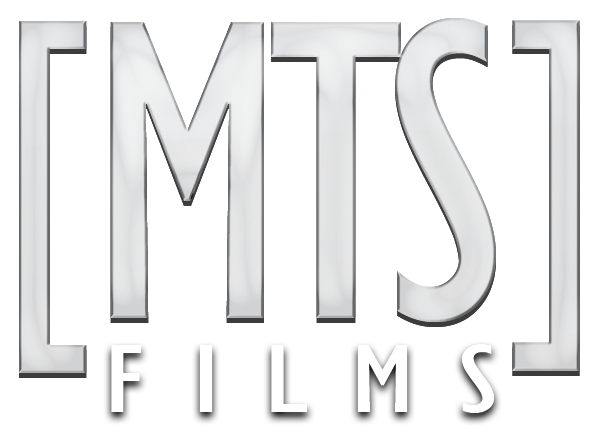Cinematic lighting is just code for lighting that has been designed to create focus and feeling. Designed, being the key word. In low budget scenarios, the designing freedom you have is limited, so, then it becomes 'designing with compromise' hehe ;) When planning or designing your lighting for any scene, it shouldn't purely be for purposes of illumination and exposure. You really should be thinking about WHAT is being illuminated, and by how much...these factors will direct your viewer's eyes to parts of the frame, so make sure you direct them precisely where you want them to look ;)
In the case above, I'm wanting the viewer to pay attention to our actor and his immediate focus. Of course the room he occupies is important, but it shouldn't be a focus. So, I lit the scene starting with a (somewhat toppy) backlight. I usually do that (especially when time is limited) because it's a quick way to create separation between your actor and the background, keeping in mind that the red curtain was already playing a part in that. I chose to balance the tungsten source to a daylight colour temperature, from 3200 kelvin to approximately 5600k using a CTB Gel. This would mean that the light's colour would match that coming from the window behind Reece. If I left it tungsten (3200K kelvin), it would appear orange on camera and become a focus in itself!
The other role of this top-heavy backlight was to create a type of 'fill light' as it bounced off of the papers in front of Reece, illuminating his face (which would normally be in shadow). I could have used a separate light to achieve this also, but it would be difficult to shape and localize (keeping it off the walls), but more importantly than that it might have even began to look "lit". Using the paper instead of a second light created a more natural lighting situation - and saved me time.
To compliment and gently amplify this scenario, I added an over-head LED light, again balanced at 5600 kelvin to maintain the lighting colour temperature. As you can see below, I used a curtain to 'cut' the light, or stop it from illuminating the walls and only light the table. Again, this comes back to the question "what are you illuminating and where do you want your viewer to look?". The downwards facing light would also bounce off of the table and paper, helping with the exposure on Reece's face. I used two layers of diffusion in front of this light which would help it seem invisible to the viewer. I don't want the audience to think there is a soft light source above the table. Diffusion creates soft shadows and makes it difficult to notice a light's direction - exactly what I needed to boost my exposure somewhat, and give the table and it's contents a little more edge.
Finally, I wanted to add a smidge of exposure to the rest of the room. I keep mentioning that I try to design my lighting with focus and intent. Where do I want my viewers to be paying attention? Well, after lighting my focus point (the actor) with the backlight and paper bounce, I then looked at the over-all scene and considered the contrast ratio of the frame. Take a step back from the actor now...how does it looks as a whole? I felt that the room's ambient light needed a small boost and decided to 'warm' that boost up a bit by NOT balancing this light to daylight.
To achieve this (as you can see in the BTS pic above) I had a 300w tungsten light (3200 Kelvin) shining into a white bounce board which was then illuminating the entire scene with a warm wash of soft light. This helped bring out some finer details that were previously lost in shadow.
You may have noticed that the highlights on Reece's shirt are blown out, or 'clipped'. That is indeed true. Generally speaking, it's not a good idea to clip highlights in your scene. Why? Because essentially it means that you giving your viewer LESS information. A clipped highlight means that there is no detail in that area - it becomes a white mass of nothingness. In the case of Reece's shirt, the edges are clipped from the strongly focused backlight - this was a deliberate decision. As I experiment and break the "rules", I'm learning that it comes back to the same old question I keep repeating "What are you illuminating and where do you want your viewer to look?". Does it matter that you cannot see any detail in the window behind our actor? I don't think so. Does it matter that you cannot see detail on the highlights of his shirt? I don't think so. More importantly, are these over-exposed or 'clipped' areas distracting or deterring your viewer from looking where you want them to look? I don't think so....but then again, I don't REALLY know. The point is, I'm conscious of what I'm designing and experimenting at the same time.
To see this shot in it's RAW, original recorded format, and to grade it yourself, I've added it to the DOWNLOADS section above. There's also a tutorial you can follow along with to see how I processed the image in Davinci Resolve if you're interested HERE.
I hope this lighting diagram and explanation has been useful! I'm always striving to learn new ways of lighting and experiment with different setups...hopefully you will be inspired to do the same. If you would like to be notified about future setups and diagrams or other tutorials and news, please subscribe using the form to the right :) There are many other lighting examples I've created in the LIGHTING section above.
Happy shooting,
Matt


